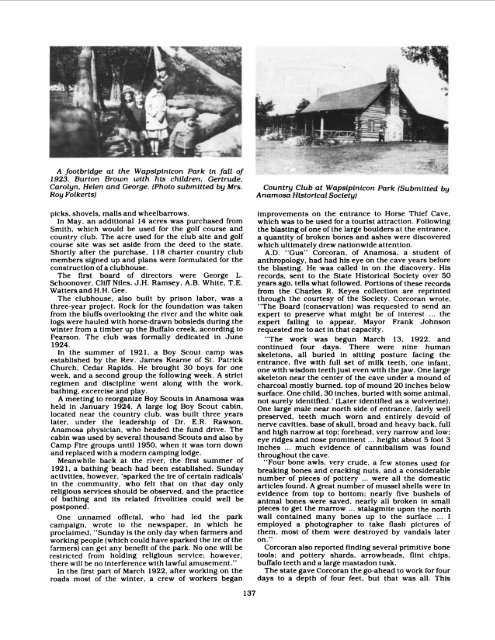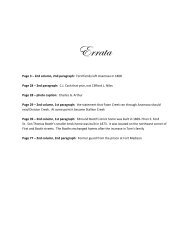Anamosa - A Reminiscence 1838 - 1988
The definitive history of the community of Anamosa, Iowa, USA
The definitive history of the community of Anamosa, Iowa, USA
You also want an ePaper? Increase the reach of your titles
YUMPU automatically turns print PDFs into web optimized ePapers that Google loves.
T"<br />
'<br />
~rt“"'=3'~+:<br />
\ ;__ .-<br />
ab.<br />
~..e<br />
A footbridge at the Wapsipinicon Park in fall of<br />
1923. Burton Brown with his children, Gertrude,<br />
Carolyn. Helen and George. (Photo submitted by Mrs.<br />
Roy Folkerts)<br />
picks, shovels, malls and wheelbarrows.<br />
in May, an additional 14 acres was purchased from<br />
Smith. which would be used for the golf course and<br />
country club. The acre used for the club site and golf<br />
course site was set aside from the deed to the state.<br />
Shortly after the purchase, 118 charter country club<br />
members signed up and plans were formulated for the<br />
construction of a clubhouse.<br />
The first board of directors were George L.<br />
Schoonover, Cliff Niles, J.H. Ramsey. A.B. White, T.E.<br />
Watters and H.H. Gee.<br />
The clubhouse, also built by prison labor, was a<br />
three-year project. Rock for the foundation was taken<br />
from the bluffs overlooking the river and the white oak<br />
logs were hauled with horse-drawn bobsleds during the<br />
winter from a timber up the Buffalo creek. according to<br />
Pearson. The club was formally dedicated in June<br />
1924.<br />
In the summer of 1921. a Boy Scout camp was<br />
established by the Rev. James Kearne of St. Patrick<br />
Church, Cedar Rapids. He brought 30 boys for one<br />
week, and a second group the following week. A strict<br />
regimen and discipline went along with the work,<br />
bathing, excercise and play.<br />
A meeting to reorganize Boy Scouts in <strong>Anamosa</strong> was<br />
held in January 1924. A large log Boy Scout cabin,<br />
located near the country club, was built three years<br />
later. under the leadership of Dr. E.R. Rawson.<br />
<strong>Anamosa</strong> physician, who headed the fund drive. The<br />
cabin was used by several thousand Scouts and also by<br />
Camp Fire groups until 1950, when it was torn down<br />
and replaced with a modern camping lodge.<br />
Meanwhile back at the river, the first summer of<br />
1921, a bathing beach had been established. Sunday<br />
activities, however, ‘sparked the ire of certain radicals’<br />
in the community. who felt that on that day only<br />
religious services should be observed, and the practice<br />
of bathing and its related frivoiities could well be<br />
postponed.<br />
One unnamed official. who had led the park<br />
campaign, wrote to the newspaper, in which he<br />
proclaimed, “Sunday is the only day when farmers and<br />
working people (which could have sparked the ire of the<br />
farmers) can get any benefit of the park. No one will be<br />
restricted from holding religious service: however,<br />
there will be no interference with lawful amusement."<br />
In the first part of March 1922, after working on the<br />
roads most of the winter, a crew of workers began<br />
T. 4"<br />
_ -. 1 _ ' '. "E1 9 Q<br />
Country Club at Wapsipinicon Park (Submitted by<br />
<strong>Anamosa</strong> Historical Society)<br />
improvements on the entrance to Horse Thief Cave,<br />
which was to be used for a tourist attraction. Following<br />
the blasting of one of the large boulders at the entrance.<br />
a quantity of broken bones and ashes were discovered<br />
which ultimately drew nationwide attention.<br />
A.D. “Gus” Corcoran, of <strong>Anamosa</strong>, a student of<br />
anthropology, had had his eye on the cave years before<br />
the blasting. He was called in on the discovery. His<br />
records, sent to the State Historical Society over 50<br />
years ago, tells what followed. Portions of these records<br />
from the Charles R. Keyes collection are reprinted<br />
through the courtesy of the Society. Corcoran wrote.<br />
“The Board (conservation) was requested to send an<br />
expert to preserve what might be of interest the<br />
expert failing to appear, Mayor Frank Johnson<br />
requested me to act in that capacity.<br />
“The work was begun March 13, 1922, and<br />
continued four days. There were nine human<br />
skeletons, all buried in sitting posture facing the<br />
entrance, flve with full set of milk teeth, one infant.<br />
one with wisdom teeth just even with the jaw. One large<br />
skeleton near the center of the cave under a mound of<br />
charcoal mostly burned, top of mound 20 inches below<br />
surface. One child. 30 inches, buried with some animal.<br />
not surely identified.’ (Later identified as a wolverine).<br />
One large male near north side of entrance, fairly well<br />
preserved. teeth much worn and entirely devoid of<br />
nerve cavities, base of skull, broad and heavy back, full<br />
and high narrow at top; forehead, very narrow and low;<br />
eye ridges and nose prominent height about 5 foot 3<br />
inches much evidence of cannibalism was found<br />
throughout the cave.<br />
“Four bone awls, very crude, a few stones used for<br />
breaking bones and cracking nuts, and a considerable<br />
number of pieces of pottery were all the domestic<br />
articles found. A great number of mussel shells were in<br />
evidence from top to bottom: nearly five bushels of<br />
animal bones were saved. nearly all broken in small<br />
pieces to get the marrow stalagmite upon the north<br />
wall contained many bones up to the surface I<br />
employed a photographer to take flash pictures of<br />
them, most of them were destroyed by vandals later<br />
on."<br />
Corcoran also reported finding several primitive bone<br />
tools; and pottery shards, arrowheads, flint chips,<br />
buffalo teeth and a large mastadon tusk.<br />
The state gave Corcoran the go-ahead to work for four<br />
days to a depth of four feet, but that was all. This<br />
1:-'<br />
'<br />
137



